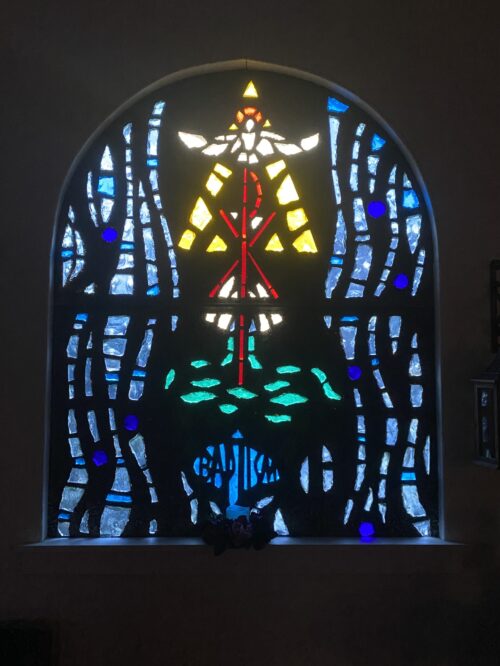Reference to Hildegard's Works:
Book of Divine Works LDO II.1 (Campbell, pp.264-347)
Click play to listen to audio description:
“Let there be priests and teachers in my Son, to illuminate the Church that was built on the solid rock that is Christ – from that stone the justice of right faith flowed forth. Let these priests be sent in to every church, illuminating it to discern for the people by their words the day – the salvation of faith – and to announce the felicity they will obtain through that faith if they keep it… (316) Let there be lights within discretion by the Holy Spirit’s gift, that a person might love God and neighbor as himself (318)… Let the lights of this work illuminate the earth – the human person – to gleam before God in mind and body” (319).
Standing in this space, as the light of day filters through these windows, the paragraph from St. Hildegard comes to life. The windows in the main body of the church depict Catholic sacramental life. Sacraments, by definition, are visible, tangible signs of God’s grace. While God’s grace exists everywhere and in everything, the celebration of the sacraments were traditionally led by an ordained priest. It is the role of a priest to bring our attention and focus to the sacred reality of God’s great love all around us. St. Hildegard understood this well. The windows here in our space beautifully depict the traditional symbols used to represent these seven sacraments.
Standing in the sanctuary, facing the west, the order of the windows are as follows:
North side of the building
- Baptism and Confirmation share a window because in the Eastern Rite (which includes Byzantine Catholic), these two sacraments of initiation are celebrated together.
- Penance, also known as Confession or Reconciliation, is depicted in the middle window.
- Holy Communion, also known as Eucharist, is above the gemstone cabinet.
South side of the building
- Extreme Unction, also known as Last Rites or Anointing of the Sick is adjacent from the ambry where we reserve the sacred oil for anointing.
- Marriage is depicted in the middle window.
- Holy Orders, also known as Ordination is depicted in the area with the music display.
In addition, there is the St. Michael window over the doors of the church, in the anchorage (formerly the choir loft), as well as a mandala window on the east wall of the sanctuary, and several abstract windows (the design feels a bit like flowing water) in the staircases and foyer.
At the right time of day, when the sun is shining, the staircase on the south side of the building becomes a brilliant green (viriditas) color from the reflection of light through the glass.
We each carry divine light within us. The Hildegard Haus windows remind us to allow that light to shine through us to others and to our world. Participating in the sacramental life of the community is one way we are nourished and empowered to share Christ Light with others.
To look up additional information on our art pieces, or find a bibliography, please click here to view our resources page.






